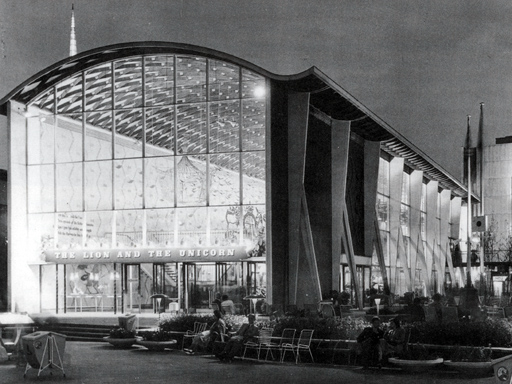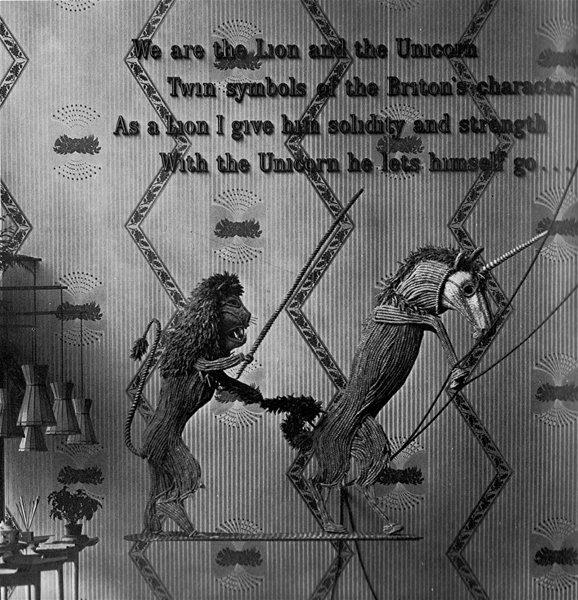What Dabbler wouldn’t like to get paid for being the government’s official Curator of Eccentricities? Worm goes in search of the man who had the best job in Britain…
When the Festival of Britain landed on the south bank of the Thames in the summer of 1951, Architect and festival director Hugh Casson unveiled “a gaily coloured scene given over to modern architecture at its most experimental and display technique at its most ingenious.”
Intending to sweep aside the physical and economic fallout of WW2, Casson assembled a festival committee to comprise of the brightest creative minds of Britain. By a stroke of luck there were plenty of creative types at a bit of a loose end since demilitarisation, all having been made redundant from their cushy wartime Ministry jobs. These artistic souls were gathered up and put to work in creating a shock and awe showcase of British culture and technology that would teach Johnny Foreigner that we were still a force to be reckoned with.
One of the aforementioned luvvies at the disposal of the Whitehall wonks was writer and poet Laurie Lee. Lee was appointed the festival’s Caption-Writer-in-Chief, and later became Curator of Eccentricities – surely one of the most excellent government job descriptions ever invented, even in this day and age of Diversity Outreach Tsars.
After writing thousands of captions for exhibits and overseeing various show publications and film scripts of the event, Lee was handed co-control of the The Lion and Unicorn Pavilion.
One half of the pavilion was given over to British history and empire; the other half to the British character. The name of the pavilion was considered to be a symbolic one in that ‘the Lion would stand for the more dependable traits in the national character, and the Unicorn for the more volatile.’
The post was to last for three years, and part of the job entailed collecting inventors’ oddities for an exhibit called Eccentrics’ Corner. Lee explained to the press:
‘Within that pavilion, there rightly belongs, we believe, a corner devoted wholly to British eccentricity and wit…For eccentricity.. we require something rich and strange, something altogether unheard of; objects, for instance, that are curious and unusual; models constructed of the most unlikely materials, ingenious machines evolved for unpredictable purposes…’
Eccentrics around Britain responded with enthusiasm, donating an egg counting device the went on the backs of chickens; a rubber bus that could be deflated to go under low bridges; a machine for grinding smoke and another for detecting the smell of broken glass in underground china shops… Humourist J.B. Morton, (better known as the newspaper columnist Beachcomber), offered a boot-rack made of polished rice grains and a concrete bowler hat.
It is easy to draw a juxtaposition between the bucolic green lanes of Lee’s Gloucestershire roots and the concrete and alloy world of the festival, but his first hit, Cider with Rosie would not be published for another 8 years. In later years, when he had moved back to his beloved Slad, Lee would come to inhabit a role that played up to the rural reverie of his most famous book, but at the time he wrote Cider With Rosie, he was a thoroughly modern man, a rakish urban aesthete, closer to Robin Day or Henry Moore than Richard Jefferies or Francis Kilvert.
Of all the exhibits, only the Royal Festival Hall was intended as a permanent feature. By the end of its allotted time, eight million visitors had passed through the Festival’s gates. The new Conservative Government, who had never been particularly keen on it, left the site as a derelict car park for many years after its closure. Lee left his post with an MBE as reward for what must have been a fairly pleasurable job.














An ideal candidate for the job, he could also have become the porky teller in chief, if one third of As I walked Out is true then I am the King of Siam.
From memory the festival was intended as a showcase for post austerity UKPLC in reality it took a further ten years of tight belts and greyness as we slowly learnt how to tell the establishment to eff off.
They came back in the end though but, having learnt banking and lawyering.
you are very right Malty, he was definitely a fabulist – Lee is on record as saying that “the only truth is what you remember”
That could describe most contemporary galleries, which are now all run by ‘curators of eccentricities’. Isn’t it impossible to be truly eccentric nowadays? I wonder whether the rot set in with this event: self-conscious eccentricity isn’t the real thing.
exactly Gaw, anyone who describes themselves as eccentric isn’t eccentric
Where have all of the eccentrics gone? is there a great graveyard somewhere, possibly in the Namibian desert, dunes littered with the ribcages of fallen oddballs, the tattered remains of their clothing flapping in the wind, gold lame string vests, powder blue loon pants and sailors caps (that would be those two characters who had the small theatrical museum in Sydenhams Venner Road of course)
As video killed the radio star so PC has done for the eccentric, the last survivor, Hissing Sid went some time ago, never innocent, forever guilty.
Eccentrics of the world unite, come down from your tree houses and revolt.
Yes, Lee could spin a yarn, as friends who came across him in Gloucestershire after he returned to Slad could testify. He could scrape by on the fiddle, though. When curating the Lion and Unicorn Pavilion, he took delivery of a violin and mandolin made of used matchsticks (I love it that they were used matchsticks: how many fags would you have to light to make a mandolin?). Lee and Jim Holland, one of the Festival designers, were soon playing Telemann on these eccentric instruments.
14,000 used matchsticks went into the construction of the Neapolitan mandolin and 20,000 for violin bow and chinrest. Jack Hall created these and other matchstick instruments during the 1930s while working as a deck-hand on board a coastal steamer. Some detailed photos, potted history and video footage are on the attached link.